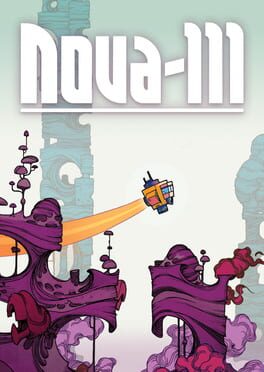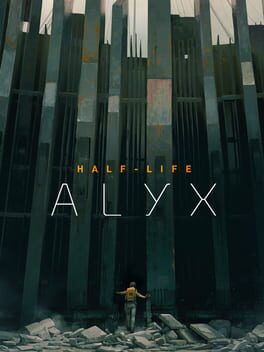miroe250
BACKER
11 reviews liked by miroe250
Sifu
2022
Assassin's Creed II
2009
And to think, I thought I was done with Celeste this month. I heard this got released yesterday, and it's free, so I had to go and play it. For only being made in a week, this is very impressive. Celeste transitions surprisingly well into 3D. You lose your upward dash in this game but everything else is here. Yes even your grab which I stupidly didn't realize was a thing until 2/3rds into my playthrough. Once I did, it definitely clicked way more since I was infinitely wall-jumping to do stuff before I learned grabbing was part of her moveset. I really like the implementation of the camera and it having a big part with the various puzzles. The early 3D atmosphere was also really nice. It never got crazy difficult like Celeste but what was here was fun. It's only like an hour long so there really isn't much content, but this could be a good stepping stone into something greater. Either way, fun game..just wish it was longer.
Also, I got all 30 strawberries, that last cassette tape under Badeline was definitely the hardest part of the game but it was very cool.
Also, I got all 30 strawberries, that last cassette tape under Badeline was definitely the hardest part of the game but it was very cool.
Really Big Sky
2012
Nova-111
2015
Tomb Raider
2013
Half-Life: Alyx
2020
Played on Oculus quest 2
With the sole exception of Beat Saber, which I gave an absentminded spin on in the local gaming bar, this was my first proper foray into the VR landscape. I had no point of reference for what to expect, but what I did have was a condescending attitude, despite that I had fun with the aforementioned title. My negative supposition stemmed from my inability to view these titles as ’’serious games’’, much like mobile games and for similar reasons. One expects them to use the technology as a crutch and in the process, forget the myriad of things that make a game, like narrative, length, pacing, progression ,variety and so forth and so forth. Games for VR have, it feels like, just recently started evolving and on account of the major financial investment they require to be played I expected it to be years before they developed their sufficient language. In a sense, I just expected a glorified tech demo.
This changed the moment I put it on. The whiteness of the loading screen and its opening titles slowly dissipate to lay bare an image of a city engulfed in smog. Before its immaculate detail can make an impression, a plethora of veiny cables supported by huge steel rail systems force your gaze to follow them upwards to an oppressive megalithic structure- The Citadel. Your nape has to bend backwards for you to investigate its ending, lost somewhere between the sky and sun, blocked by thick haze. It’s in my first moment with the game, that the VR system makes me feel something I wouldn’t have without it. The towering presence of the Combine Headquarters has its intended dominating effect on me precisely because real life movement enabled me to feel it. Speedy aircrafts take off left and right; huge mechanical spider-like government sentinels roam the rooftops scouting for trouble; the only organic life form is a tiny (in comparison) pigeon flock that wizzes past you in a second; I veer my head frantically to catch it all. I haven’t even started moving yet and I’m dumbfounded. Looking around is more than enough for my first minutes with it. It’s surprising to me that I have found the space to be as immersive as it has been, that I immediately accepted the presented reality and found it palpable. I see a railing in front of me and cautiously peep my head over it as if a chance of a fall existed; I already respect the depth of the world subconsciously. It also helps that Valve have gone to extremes to describe the detail of this world, both visually and mechanically. After I surveyed the street and its passengers I noticed a radio on my right. A core frequently asked question that comes to you throughout the entire game arises in that moment: ’’Can I ?’’, a mark of any great game. My fingers aim for its little antenna and I raise it to receive the signal. It works. I go for the knob and it turns. I bend over, pick up a matchbox and shake it beside my ear to hear the trembling of the matches inside. I lift a pot and wonder if can time it’s fall and drop it on a pedestrian's head. It doesn’t work ( didn’t expect it to), but I'm already in play with the systems. The physics engine reputation Valve has built hasn’t been damaged and City 17’s tangibility invites one to see what it’s made of. My appetite for experimentation is growing and I begin to see how much unknown the space for play is.
I wonder if it is a coincidence that VR has finally emerged as a real thing when graphics have become photorealistic, or hit the gradient of becoming. I’m sure a basic, low poly version of this would still extract a reaction out of me and have merit; yet, it’s full mesmerising effect hits due to the cutting edge graphics worthy of a non-vr competitor game. While you enter your first interior in the game, you walk through a dingy corridor. Not that it has anything to do with it, but at that moment I got reminded of P.T, Kojima’s infamous unreleased cult project and its treatment of light shadow, texture and reflection (The Order 1886 also sprung to mind for similar reasons). Naturally, graphics have been moving the bar ever since 2014, but it was at the beginning of that demo that I thought a new graphical fidelity plateau was established, and not just by pure graphical horsepower alone. It was in the way it gave them the opportunity to express drama through it, how light reflected off different surfaces, while still allowing for the personality of the material to be noticed, like stains on mirrors or smudges on the floor. It could account for the whole spectrum of light and shadow, having a corner of room in pitch darkness, and then gradually transition to full lightning. The same physical based rendering techniques are present in Alyx and it is many a times where it’s detail made an impression; entering an abandoned hotel lobby, singularly illuminated by sunbeams suggesting all the unclear air and accumulated dust by the years of neglect; fighting for dear life in a pitch black basement with a flashlight, only having some light reflect of smeared old monitors and dirty ceramic tiles or just taking in the last sunset rays bathing the industrial buildings sheet iron rooftops.
It was after my initial techno stupor wore off, that I noticed my hands and was intrigued at how they shadowed my real life movement so well. The mind connection I made between my real hands and virtual counterparts was mind boggling. I inspected them thoroughly, their back and front and I moved them closer to my face and really far from it. For all intents and purposes these were my ’’real’’ hands, and as such, they became the most intuitive controls any game has ever had. I had many of my friends come and try it out and it’s always the same, despite the major difference in gaming experience we all had. By the fifth minute of the game, by the time you go down the elevator, they play with it as if they have done this their whole life, and in a sense, they had. Drawing from real life experience of the physical world, walking, crawling, tip-toeing to see something, even shooting had become a second nature in the game. These types of controls minimise the gap between intent and execution of action so much that it practically opens a new horizon for 3D space. An interesting instance of this is the concept that hands and head are tracked separately, which might not sound like much, but brings so much more life to the virtual world. You can open a door with your right arm slightly, just enough for you to peek inside and have your gun ready to terminate with you left, while you still hold the door with your right one, prepared to close it and protect yourself from danger. You turn cranks in panic, hoping for a door to open before some (beautifully rendered) freak gets you, cycling in the process between him, the door and the crank. Chances are you fumble in your haste to reload and drop the life saving mag you could not reload. I could also never resist the temptation to break glass whenever I had the chance. To watch it shatter piece by piece while I was trying to make an opening in for my grenade was a delight .The examples of this are many and it made me think that I hadn’t really noticed how classical controls lacked this continuity of motion and made these in-between moments of tension and discovery get lost between the cracks.
The remarkable thing all of this manages to do is make you reinterpret conventional video game syntax. It is indescribable how different the process feels, when you have to perform an action in its full capacity. It reinvents the basics, like walking, picking ammo, reloading, throwing, aiming a flashlight, lining a shot yourself, and even the tedium of looting. Raviging kitchen drawers and cabinets has never been this involving. Changing ammo isn’t a heedless press of a button, but a whole affair of reaching behind your shoulder to an imaginary backpack and performing the magic hat trick of pulling out not a rabbit, but a fresh clip. After that you have to manually cock the weapon to use it, which you often do and it never gets old.
The shooting is in the same vein, familiar and also different, enhanced by a witty gameplay addition on Valve’s part, very similar to the Gravity Gun in Half-life 2. The big deal with that weapon, despite that it was really cool to play with, was the use it made of the groundbreaking physics engine made for Half-life 2. In a similar stroke of pragmatic genius, they’ve replicated this in Alyx with the introduction of the Gravity Gloves. The VR realm is a great place to update this concept, because on one hand it provides a tool for you to experience the tangibility of the objects in the world while you zap them around; on the other hand, it swiftly deals with a problem the devs would’ve had, that is present in any normal shooter i.e the picking of ammo, or for that matter, everything else. In Alyx, you just extend your arm and beckon at the desired object (usually ammo) for it to soar in your direction. Before you know it, you already use it on the baddies and continue on your path of destruction. Could you imagine if you had to walk to every piece of ammo or collectible on the ground and bend over to pick it up? With the gravity gloves you avoid redundancy and insert a really fun sense of pace into the gameplay, which consists mainly of shooting stuff hither and thither.
It's enjoyable to face off against the headcrabs and their hosts, but the action shines once you have your first fight with enemy soldiers that can shoot back. As the synth and drums start blasting their beat, enemy fire becomes the supporting background music to the encounter. I land a couple of shots, but then duck behind a shielding concrete column and cower on my left knee, waiting for the enemy fires to cease. I pop up from my cover for a second, enough for me to squint an eye and headshot a dude, immediately after which I renew my safe position that's still getting shot at by the remaining soldiers. I giggle, imagining myself in my living room, hunched, playing pretend. It looks like a scene in a sci-fi movie that’s not even twenty years old, yet it’s my current reality and I participate in the outlandish scenarios people envisioned we’d have in the far future. Sure, it gets you a little dizzy if you play sessions longer than an hour and a half and you second guess your judgement of reality in the first moments you remove the headset, but it doesn't have the dystopian feeling I expected it to have. Instead, I’m engaged in a game, something that happens less and less in today's overblown mega budget titles and want to see what its systems can do.
It doesn’t take much time for me to fully roleplay while doing this. It's definitely not required, but it feels like such a shame if you miss the opportunity to do so; you have the tools to take so much out of this. The Combine militia enters the arena and I reach for safety. They open relentless fire on my position and stop me from moving anywhere. A grenade lands beside my feet, thrown by a frustrated soldier that can’t get to me. Escape is impossible due to enemy fire and death seems imminent. It’s out of reach, but I have a couple of seconds to get to it before the explosion proves fatal. The looney tunes bulb above my head lights up and I remember my trusty gravity gloves. I extend my arm and the speedily beeping grenade teleports in my grasp. The physics engine of the game creates a reliable realistic world and the intuitiveness of the controls invite you to test its limits and it’s so fun when you do and have your curiosity rewarded. I throw it back at them, which opens a window for me to escape. Later, they have me pinned down again and force me to crawl to my nearest cover. I frantically exit my shielding and shoot, then duck again several times. My health isn’t enough for me to stay in the dangerous open for long. I try to shoot blindly by bending just my wrist and pistol around the corner, while the rest of my body is still protected. I empty the entire clip and it seems in vain. I can’t tell if I got someone but the prospect of it was fun. I lay on my belly and press the stick forward, while moving my limbs like a crab, emulating the real life motion of crawling to escape the situation. I move intensely in real life and in the game and my heart is racing from the physical activity. Everyone, but an advancing heavy combine soldier is terminated. A remaining shotgun shell is my only ammo left available and I scour the surrounding for anything that can help me. I'm out of luck and wait for my demise with my last remaining drop of health. Like Trinity in the iconic scene in The Matrix, I wait flat on my back, both of my arms pointing at the space where I expect the grunt to appear to finish me off. His breathing and walking can be heard and is clearly getting closer. The intensity ramps up and I can feel the salt from my sweat dripping from my brow to my mouth. I'm frozen like this and starting to feel fatigue in my upper abdominal muscles because I’ve been contracted in this position for a while. The thumping gets louder and louder. I dare not blink, for I could miss the exact frame he appears to end me. As soon as his silhouette appears above me I blast him with my last remaining shell to save myself and continue on. If that ain't cool I dont know what is.
The biggest fault of the game is how uninteresting the plot and narrative are to the point that Alyx might not even classify as a game that has them. You just fuck around a lot to get MacGuffins and listen to people who give you instruction via comms. Not that different from it’s predecessors, but this one has a distinct lack of character and even semi-interesting writing. I doubt a single line of dialogue will affect you in any way. It’s easy to speculate that they deliberately made it this way in order to protect the ’’canon’’ of the Half-life universe by making a game that wouldn't make a dent in the overarching narrative. Is it because they didn’t want to alienate people that could not afford the hefty asking price of a game and whole system or was it due to fear that a bad experimental title would tarnish the legacy of the series. I personally couldn't care less but this franchise has zealous fans and Valve is aware of that. It’s a shame that they did not try more in this department, but in the end, it doesn’t bother me that much and I close my eyes to this just for the ending. So much else is at offer here, that it feels petty to critique.
All these descriptions I have given of the Alyx experience is to illustrate how special a step it is, if not the leap people fear it could be; it doesn’t work if it’s not in VR. I watched as my friends gave it a spin and it was boring as shit. It looked like any old game, or even worse, thanks to the inherent jankiness and silliness of titles made for VR. The shift in perspective is just untranslatable to normal screen based gaming. The success of this title is summarised in this quote by lead designer David Speyrer: ’’... yeah, we’d watering down the VR experience to try to do both at the same time, and as we explored the idea it just drove us in a place where the game became essentially VR, not just superficially VR.’’
With that core production philosophy Valve also crafted the epilogue. Right at the tail end of it, a final moment of interactability is presented to you. In a standard game, a press of a button would suffice, even if the physical action was the same. In Alyx, you have to do it yourself. Extend your arms and receive what is offered. As I was doing it, I felt the weight of action more and was awestruck again by the wit of it. This one moment made me excited for the future of VR and how a story might be told uniquely by this specific branch of gaming in the future. Hands off to Valve for that. It's insane that they put their chips on niche hardware that only bourgeois gaming royalty will be able to afford, made an exclusive twenty hour game for it that actually delivered both a worthy sequel to a beloved franchise and made a technological leap in history. It doesn't birth anything new, but brings a different perspective that shows what we had before in a different light and gives a glimpse of what we might have in the future. I can’t wait to find out what that is.
P.S the Jeff chapter rocks and the collapse of the Vault was one of the coolest things
I acknowledge my belated entry into the conversation, and I'm aware of the potential cliché in praising this game. However, I cannot help but express my admiration for how the atmosphere of Hollow Knight skillfully transported me into its magical world. The music, the design, and the dystopian salvagepunk elements collectively create a sensation of playing in a realm beyond the accepted boundaries of civilization. It truly feels like a place where the Pale King made his final stand against the relentless onslaught of chaotic disintegration.
While I haven't delved into other metroidvania games, I dare say Hollow Knight stands as the pinnacle of its genre. It consumed 50 hours of my time to reach the end, albeit without facing the Radiance. Now, here lies my quandary. The more I explored the game's lore and pondered its intricacies, the more I detected an unsettling aspect surrounding the mid-game introduction of the dream element. I didn't care to fight extra bosses, nor did I have any interest in the gods and the arena.
Aye, there's the rub. Hollow Knight is an intimate game, and the sense of loneliness and isolation is an integral part of the world. Therefore, any attempt to increase the number of bosses and introduce unnecessary complications for the players, just for the sake of it, feels immature—especially in contrast with the restrained style that prevailed before encountering the moth.
I don’t want to fight Radiance. Not just because it’s hard, but because it feels like a violent twisting of the arms. You don’t get the true ending unless… you find the dream nail and upgrade it, spending more hours on silly tasks instead of playing the game you enjoyed so far. I don’t need stupid gods and mythology for this abandoned world because that’s the point – it is abandoned, there are no gods, everyone is alone unti this melancholy knight comes around and starts helping. Like in a Kurosawa movie. The knight should remain a stranger, and The Hollow Knight should stay his possible future.
While I haven't delved into other metroidvania games, I dare say Hollow Knight stands as the pinnacle of its genre. It consumed 50 hours of my time to reach the end, albeit without facing the Radiance. Now, here lies my quandary. The more I explored the game's lore and pondered its intricacies, the more I detected an unsettling aspect surrounding the mid-game introduction of the dream element. I didn't care to fight extra bosses, nor did I have any interest in the gods and the arena.
Aye, there's the rub. Hollow Knight is an intimate game, and the sense of loneliness and isolation is an integral part of the world. Therefore, any attempt to increase the number of bosses and introduce unnecessary complications for the players, just for the sake of it, feels immature—especially in contrast with the restrained style that prevailed before encountering the moth.
I don’t want to fight Radiance. Not just because it’s hard, but because it feels like a violent twisting of the arms. You don’t get the true ending unless… you find the dream nail and upgrade it, spending more hours on silly tasks instead of playing the game you enjoyed so far. I don’t need stupid gods and mythology for this abandoned world because that’s the point – it is abandoned, there are no gods, everyone is alone unti this melancholy knight comes around and starts helping. Like in a Kurosawa movie. The knight should remain a stranger, and The Hollow Knight should stay his possible future.









